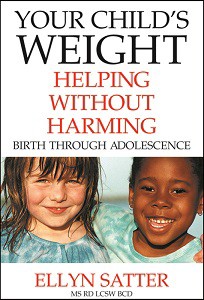
Feeding to prevent child weight acceleration
An Ellyn Satter Institute Position StatementFeeding to prevent child weight acceleration
Ellyn Satter, MS, MSSW Dietitian and Family Therapist
From the perspective of the Satter Feeding Dynamics Model, ESI considers child weight issues from a competency based perspective. That is, the issue is weight acceleration: abnormal upward weight divergence for the individual child. Based on this clinical definition, each child is compared to only him- or herself, not to statistical cutoff points established for the purpose of population-wide evaluation. This definition avoids labeling as overweight the child whose weight, weight-for-height or BMI are above a certain percentile but is growing consistently. It also allows identifying for early intervention the child whose measurements fall closer to the mean but is nonetheless diverging from his or her previously established growth pattern.
Redefining child weight issues as weight acceleration reframes prevention
Rather than avoiding overweight, the emphasis becomes supporting each child’s normal growth. Thus, child overweight can be prevented from birth with appropriate feeding. Growth acceleration can be treated by examining the underpinnings and antecedents of the divergence, restoring positive feeding and letting the child’s own capability with energy and growth regulation resolve the problem. Each child has a powerful and resilient ability to eat the right amount of food in order to grow in accordance with his or her genetic endowment. However, each child needs appropriate support from parents and other care providers in order to be able to eat and grow well—to manifest that genetic endowment.
Feeding demands sDOR throughout childhood
Parents and other care providers provide appropriate food and allow children to eat as much or as little as they want of what their grownups provide. Depending on the child’s stage of development, sDOR plays out in different ways::
- The infant eats and grows best when he or she is fed on demand, with parents and other care providers guiding feeding based on information coming from the child with respect to timing, tempo, amount and level of skill.
- The older baby eats and grows best when parents and other care providers observe the child’s individual sequence of oral-motor development and provide appropriately modified food to support the child’s gradual transition from semi-solid food to soft table food.
- The toddler, preschooler and older child eat and grow best when they have both leadership and autonomy. ether of eating. Parents and other care providers of older children are responsible for the what, when and where of feeding; children remain responsible for the how much and whether of This division of responsibility continues to be essential throughout the child’s growing-up years.
The intervention: Teach effective feeding
Professionals who work with children are in a powerful position to teach and support parents in effective, stage-appropriate feeding. Moreover, professionals can help parents accept each child’s consistent growth pattern, even when that pattern is outside statistical cutoff points. Finally, early childhood professionals can do early intervention in response to feeding complaints or minor growth divergences. With early intervention, those minor issues can be kept from exacerbating into seriously distorted feeding and weight patterns.
For further information
- Satter, EM. Your Child’s Weight: Helping without Harming, Kelcy Press, 2005.
- Satter EM. Internal regulation and the evolution of normal growth as the basis for prevention of obesity in childhood. Journal of the American Dietetic Association. 1996;9:860-864.
- Satter EM; Chapter 2, “Your child knows how to eat and grow and Appendix J. Children and food regulation: The research. Child of Mine; Feeding With Love and Good Sense. Palo Alto, CA: Bull Publishing; 2000.

